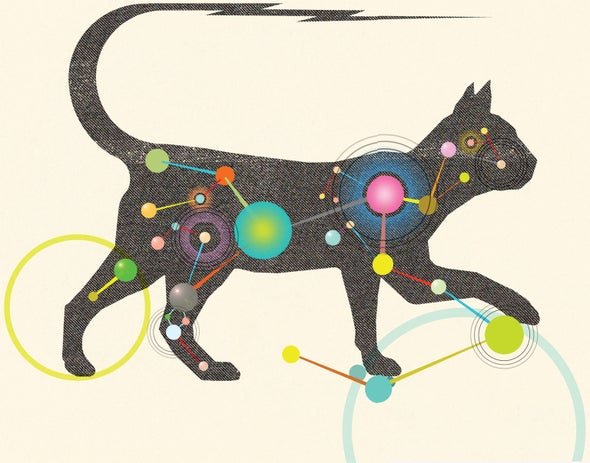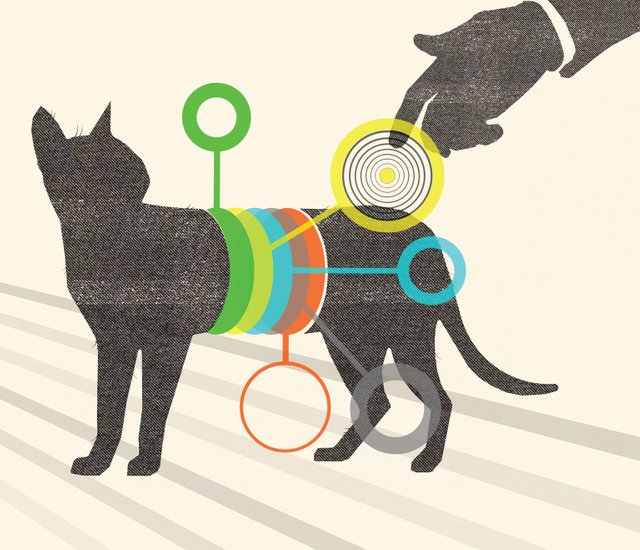The Inner Life of Cats
If you have ever wondered why your cat behaves the way it does, wonder no more

ASK ME ANOTHER
Interview by Kate Wong
As anyone who has spent time with cats knows, our feline companions are mysterious—much more so than those other furry family members. Here John Bradshaw, author of Cat Sense (Basic Books, 2013), fields a selection of questions submitted by Scientific American editors and Twitter followers about the cat’s many quirks. Bradshaw is a visiting fellow at the University of Bristol School of Veterinary Sciences in England, where he studies the behavior and welfare of cats and dogs, as well as their interactions with people.
Are cats less domesticated than dogs? Are they becoming more domesticated over time?
Cats are far more similar to their wild ancestors than dogs are to wolves, so dogs are in that sense the more domesticated of the two species. As they adapted to living alongside humans, cats became more sociable with one another and much more accepting of people, but there is no evidence that they have changed much more than that over the past few thousand years.
Will cats, which require meat, eventually evolve to eat a broader array of foods as dogs do?
Cats and dogs belong to a group of mammals known as Carnivora, and the wild ancestors of both species dined primarily on meat. Recent DNA analyses indicate that over the course of their evolution, dogs have acquired more copies of the so-called amylase gene, which makes an enzyme that helps to break down starch. Having more copies of this gene has allowed dogs to eat a more omnivorous diet. In contrast, the cat family, known as Felidae, lost the genes that encode several key enzymes—including those that manufacture vitamin A, prostaglandins and the amino acid taurine—early in its evolution. Whereas dogs (and humans) can synthesize these substances from plant-based precursors, cats have to obtain them from meat. To expand their diet, cats would have to evolve physiological traits that allow them to synthesize these and other key nutrients from plant foods. This capacity has not emerged during the 10 million years of felid evolution, so it seems unlikely to arise spontaneously in our domestic cats.
Why do cats purr?

Cats purr because they have something to say, which roughly translated is “please keep still and pay attention to me.” Kittens purr to persuade their mothers to keep on nursing them, and pet cats purr when they want to be stroked. The vibrations emanating from the purr certainly have a calming effect on people. Yet sick cats will also purr as a cry for help. So purring doesn’t always mean “I’m happy.” Some researchers have claimed that the vibrations from purring might help heal bone damage in an injured cat.
Credit: Mark Allen Miller
How do they purr?
The purr is an unusual vocalization, made by rattling the vocal cords together rather than vibrating them by pushing air past them, which is how cats—and humans—generate all their other vocal sounds. That’s why cats can purr when they’re breathing in and breathing out. Most species of wildcats can purr, including the cheetah. The exceptions are the big cats—lion, tiger, jaguar and leopard—whose voice boxes are modified so that they can roar.
Why do house cats have so many vocalizations compared with wildcats?
House cats are much noisier than feral cats, although they have fewer vocalizations than some other species. The jungle cat from Asia, for example, has a couple more that are not in the house cat’s repertoire, namely the “ow” and the “gurgle.” The house cat’s characteristic sound, the meow, is hardly ever heard in feral cat colonies, except occasionally when mother cats are communicating with their kittens. Feral cats diligently monitor one another’s comings and goings, so they don’t need to announce their presence vocally. Cats that live with humans, however, learn that meowing is a good way of getting our attention: our pet felines often find that we have our noses buried in a book or a screen, so they meow to get us to acknowledge them. Some pets develop a “private language” of meows that only their owners understand, each signifying something different that the cat needs. Also, certain breeds are notoriously chatty, the Siamese in particular.
.jfif)
.jfif)